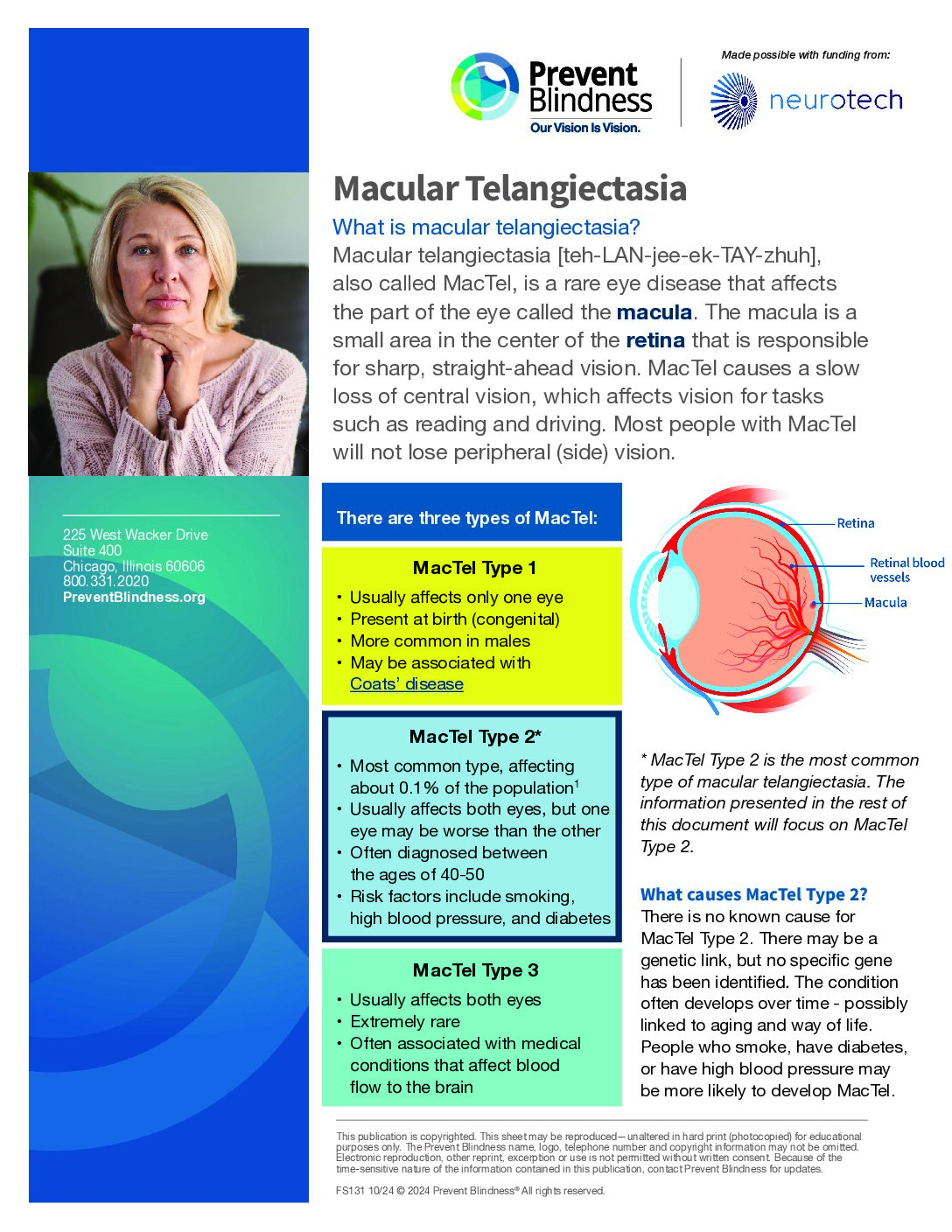What is macular telangiectasia (MacTel)?
Macular telangiectasia [teh-LAN-jee-ek-TAY-zhuh], also called MacTel, is a rare eye disease that affects the part of the eye called the macula. The macula is a small area in the center of the retina that is responsible for sharp, straight-ahead vision. MacTel causes a slow loss of central vision, which affects vision for tasks such as reading and driving. Most people with MacTel will not lose peripheral (side) vision.
MacTel Type 2 is the most common type of macular telangiectasia. The information presented on this page will focus on MacTel Type 2.
Anatomy of the Eye
Download, Print, and Share the MacTel fact sheet:
MacTel Type 2: A Community Forum for Sharing Knowledge and Support
There are three types of MacTel
What causes MacTel Type 2?
There is no known cause for MacTel Type 2. There may be a genetic link, but no specific gene has been identified. The condition often develops over time – possibly linked to aging and way of life. People who smoke, have diabetes, or have high blood pressure may be more likely to develop MacTel.
Recent studies suggest that MacTel is a neurodegenerative disease, which means that over time, certain cells become damaged and unable to work well.
MacTel damages the retina tissue, decreasing the retina’s ability to sense light. MacTel can also lead to changes in the tiny blood vessels in the retina. This deterioration occurs slowly and can result in the loss of central vision, usually over a period of 10 to 20 years.
What symptoms might I have with MacTel Type 2?
The most common symptom of MacTel is a gradual loss of central vision in one or both eyes. MacTel develops slowly, so it may take several years to notice any vision issues. Most people don’t notice symptoms until they are over 40 years old. MacTel typically does not affect peripheral (side) vision.


How is MacTel Type 2 diagnosed?
Because vision loss happens gradually with MacTel Type 2, most people are 40-50 years old when diagnosed. Diagnosis of MacTel typically starts during an eye examination with an eye doctor. If the eye doctor thinks you have a problem with your retina, they may ask you to see a retina specialist, an eye doctor more experienced in diagnosing and treating retinal diseases. The retina specialist will ask about your medical history, review your family medical history, and conduct further testing to confirm your diagnosis.

An Amsler Grid may appear distorted to individuals with MacTel
Images courtesy of the National Eye Institute
What is the treatment for MacTel Type 2?
There is currently no FDA-approved treatment for MacTel Type 2, but there are clinical trials in process that may lead to treatment options. Continue to see your eye doctor as recommended and report any changes in your vision. It is important to have an eye doctor check your eyes regularly as other eye health conditions can occur.
MacTel can cause abnormal blood vessels to grow and sometimes leak into the retina. This is called choroidal neovascularization [nee-oh-vas-kyuh-ler-uh-ZEYshuhn]. If you have these unusual blood vessels, your eye doctor may treat them by injecting medication into your eye.
MacTel and clinical trials
Find out how clinical trials are conducted
Search for current clinical trials for MacTel at ClinicalTrials.gov
As you explore clinical trials, talk to your eye doctor, and consider the following advice from the Federal Trade Commission:
- Never participate in a study that asks you to pay to be in their study or to learn about their study.
- Never participate in a study that asks for your Social Security number, bank account, or credit card during recruitment or screening.
- Do an online search before you join any study. Search using the name of the clinical trial and the words “scam,” “review,” or “complaint.”
How does MacTel affect mental health?
MacTel can cause loss of vision. For some, loss of vision can lead to feelings of depression, anxiety, and loss of independence. Some individuals may notice a change in their desire to socialize with others, or increased frustration with the additional time it may take to accomplish tasks of daily living. Not everyone who has vision loss will experience mental health symptoms, but if you do, there is help available.
To help support your mental health while living with MacTel:
Talk to your primary care doctor, mental health professional, or eye doctor: Talk to your doctor about any changes in your emotional well-being. Ask your eye doctor how MacTel might affect your daily life and work. Seek assistance on how to cope with the changes in your life due to MacTel.
Seek support: Look for support groups of others who are living with MacTel. These groups can help you learn about your condition, share your experience, and find support.
Connect with others and the things that bring you joy: Stay connected with friends and family to keep you from feeling isolated. Over time, you can find new ways to do the things you love or discover new hobbies that bring you happiness.
Exercise: Physical activity can improve symptoms of depression or anxiety and help you feel better. Talk to your health care professional to determine what exercise routine may work best for you, especially if you have changes to your vision due to MacTel.
Seek vision rehabilitation: Ask your eye doctor to recommend a low vision specialist. The specialist can help to maximize the use of the vision you have.
“I received my MacTel diagnosis 24 years ago and today I still consider myself very functional, especially with adaptations. Being diagnosed with a degenerative eye disease motivated me to enjoy life to the fullest.”
– Debbie T., patient living with MacTel
Additional resources for those with MacTel
Living Well with Low Vision: Find practical ways to improve your quality of life and relieve the emotional trauma that often accompanies low vision.
The ASPECT Program: The ASPECT Program (Advocacy, Support, Perspective, Empowerment, Communication, and Training) empowers individuals to be engaged in their eye health.
Uncovering MacTel: Learn more about MacTel, get tips for living with MacTel, and find support.
Lowy Medical Research Institute (LMRI): LMRI is a research organization dedicated to preventing vision loss in people with MacTel.
The Blind Life: Find videos, tips, and insight for those living with vision loss.
Thriving Blind Academy: Access free and paid programs promoting literacy, employment, and financial awareness in the blind community.
Hadley: Hadley offers practical help, connection and support free of charge to anyone with a visual impairment, their families and professionals supporting them.
Guide Dogs of America/Guidedog.org: Find information on guide dog services in the United States.
These resources are being provided for informational and educational purposes only. Prevent Blindness is not responsible for the content of external sites, and any views or opinions expressed in external groups represent only the individuals providing them.
This web resource is made possible with funding from:







